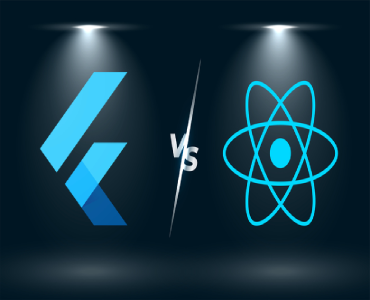
Introduction to Flutter and React Native
Flutter, developed by Google, is an open-source UI software development kit (SDK) that allows developers to build natively compiled applications for mobile, web, and desktop from a single codebase. Flutter employs Dart as its programming language and utilizes a reactive framework.
React Native, created by Facebook, is another open-source framework for building cross-platform mobile applications. It enables developers to use JavaScript and React to build mobile applications for iOS and Android platforms, sharing a significant portion of the codebase between them.
Performance
When it comes to performance, both Flutter and React Native offer commendable results, but they achieve it through different mechanisms.
⦁ Flutter: Flutter boasts impressive performance due to its unique architecture. It utilizes a compiled programming language (Dart) and a custom rendering engine, Skia, which allows Flutter to deliver consistent 60 frames per second (fps) performance. Additionally, Flutter’s hot reload feature enables developers to see changes instantly, facilitating rapid iteration and debugging.
⦁ React Native: React Native relies on a bridge to interact with native components, which can introduce performance overhead, especially when dealing with complex UI animations. However, React Native has made significant strides in improving performance, leveraging tools like Hermes for JavaScript optimization and TurboModules for enhancing bridge performance.
Development Experience
The development experience encompasses factors such as ease of setup, development tools, community support, and developer productivity.
⦁ Flutter: Flutter offers a streamlined development experience with its rich set of built-in widgets, extensive documentation, and an intuitive UI framework. Flutter’s hot reload feature significantly accelerates the development process by allowing developers to instantly view changes without losing the app’s state. Additionally, Flutter provides comprehensive tooling support, including IDE plugins for popular editors like Visual Studio Code and Android Studio.
⦁ React Native: React Native, being based on JavaScript and React, leverages a vast ecosystem of libraries and tools. It offers a familiar development experience for web developers transitioning to mobile app development. React Native’s community-driven ecosystem provides numerous third-party libraries and components, enabling developers to leverage existing solutions for various functionalities.
UI Flexibility and Customization
Both Flutter and React Native offer powerful capabilities for designing and customizing UI components, but they differ in their approach.
⦁ Flutter: Flutter provides a rich set of customizable widgets and allows for pixel-perfect UI designs across different platforms. Since Flutter renders its own UI components, it offers greater control and consistency in UI rendering and behaviour. Developers can create complex UI animations and effects using Flutter’s built-in animation library.
⦁ React Native: React Native adopts a more native-centric approach, leveraging platform-specific UI components. While this approach ensures that apps have a native look and feel, it may result in inconsistencies across platforms. React Native provides the flexibility to create custom UI components using a combination of JavaScript and platform-specific code, but achieving pixel-perfect designs may require additional effort.
Community and Ecosystem
Community support and ecosystem maturity play a crucial role in the long-term sustainability and success of a framework.
⦁ Flutter: Flutter’s community has been rapidly growing, driven by Google’s backing and its appeal to developers seeking a modern, reactive framework. Flutter’s ecosystem includes a growing number of plugins and packages for integrating with various services and functionalities. However, Flutter’s ecosystem is still evolving compared to more established frameworks like React Native.
⦁ React Native: React Native enjoys widespread adoption and a mature ecosystem, thanks to its early introduction and support from Facebook. The React Native community is vibrant and active, with a plethora of third-party libraries, tools, and resources available. This extensive ecosystem contributes to React Native’s popularity and makes it an attractive choice for developers.
Conclusion
In conclusion, both Flutter and React Native offer compelling solutions for cross-platform mobile app development, each with its own strengths and considerations. The choice between the two ultimately depends on factors such as project requirements, developer preferences, and long-term objectives.
⦁ Choose Flutter if you prioritize performance, UI flexibility, and a streamlined development experience, especially for apps requiring complex custom UI designs and animations.
⦁ Opt for React Native if you prefer a JavaScript-based development approach, seamless integration with existing web technologies, and access to a mature ecosystem with extensive community support.
If you are looking for a free assistance for your mobile app, you can always contact us via email at hello@softsourcetech.com or you call us at +91-9724434002.






